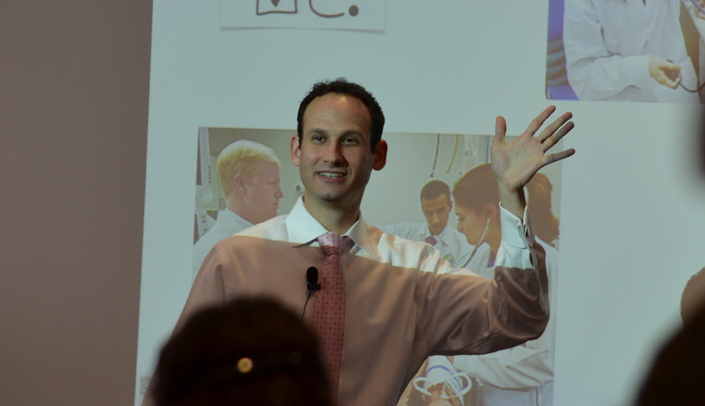To hear Adam Persky, Ph.D., tell it, a flipped classroom could just as easily be called an active classroom.
Dr. Persky, clinical associate professor of pharmacotherapy and experimental therapeutics at the University of North Carolina’s Eshelman School of Pharmacy, was a featured speaker at the recent event, “The Flipped Classroom in Health Professions Education: Expanded Interactive Learning at UNMC.”
He addressed a full house at the Maurer Center for Public Health’s third-floor auditorium.
His program was co-sponsored by UNMC Faculty Development and the College of Pharmacy.
Greg Karst, Ph.D., assistant dean for academic and student affairs in the School of Allied Health Professions, was impressed. “It’s using evidence to guide where we should be going in curriculum reform,” he said.
Dr. Persky is armed with reams of evidence: study after study that shows how information is best retained and retrieved — often by interactive learning, rather than by passive listening. Biologically, he said, “We were not meant to sit in classrooms all day.”
Lecturing does not lead to critical thinking: “Discussion does. Peer teaching does.”
But keeping his classroom active has a side effect.
“Students learn more,” Dr. Persky said. “But they don’t like the course. I’m asking them to do more.”
He doesn’t let them get comfortable. By definition, that’s caused some discomfort.
The longer his classroom has been “flipped,” the lower his teacher ratings have become.
One student said, “I don’t know if I’m learning stuff because of all this active learning.”
“You got a 99 on the last exam!” Dr. Persky told the student.
Another wrote, in an evaluation, “I don’t feel like Dr. Persky taught me anything. I learned it all on my own.”
“Yes you did!” Dr. Persky crowed triumphantly.
But not all of the increased workload will fall to the students under new educational models. And, students likely won’t be the only ones made initially uncomfortable by a changing world.
Yet “a lot of early adopters are right here,” Dr. Karst said. Every seat in the room was filled.
Dr. Persky’s presentation included examples of specific techniques. But his driving theme was that there is ample evidence out there that can be translated into a better way of teaching and learning. Evidence says this stuff works.
Evidence also tells us this:
“Learning is hard,” Dr. Persky said. “Students want it to be easy. We want it to be easy.
“It’s going to be hard.”
